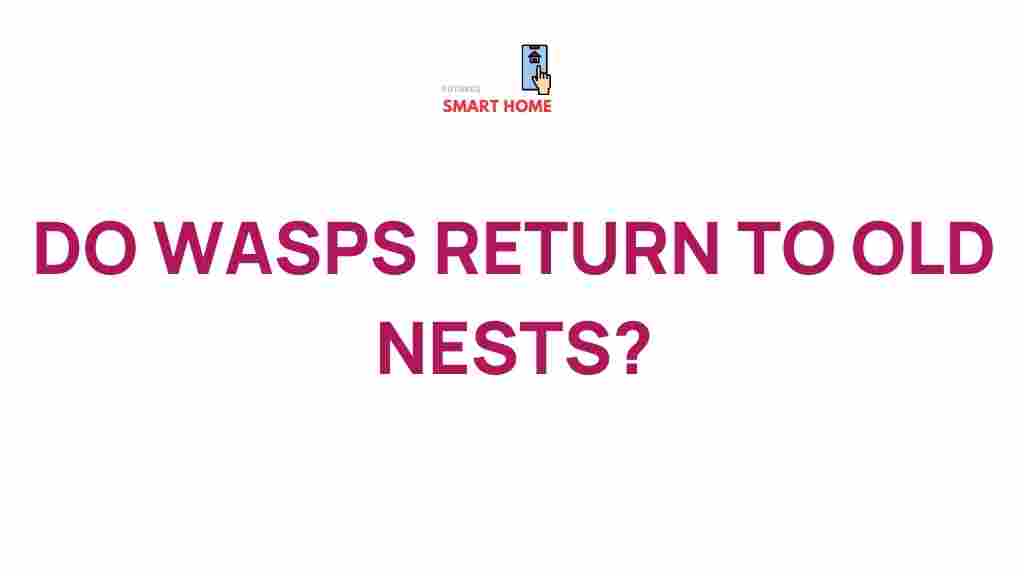Unraveling the Mystery of Wasp Nest Reuse
Wasps are fascinating insects that play significant roles in our ecosystems, yet they often evoke curiosity and fear due to their behavior. One of the most intriguing behaviors exhibited by these insects is their tendency to reuse nests. This article will explore the science behind wasp nest reuse, delving into the mystery of why and how wasps engage in this behavior. We will look at various studies, behavioral insights, and the ecological implications of this phenomenon.
The Science Behind Wasp Nest Reuse
The reuse of nests by wasps can be categorized into different types based on their species and environmental factors. Understanding this behavior begins with recognizing the biology of these insects.
- Social Structure: Wasps, particularly social species like yellowjackets and paper wasps, operate within complex social hierarchies. Nests serve as hubs for their colonies.
- Resource Efficiency: Reusing a nest can save energy and resources that would otherwise be spent on constructing a new one. This is crucial for survival, especially in harsh conditions.
- Protection from Predators: Established nests provide a level of protection from predators, making reuse a strategic choice.
Studies have shown that certain wasp species will return to previously constructed nests if they are still intact and in a suitable location. This behavior raises questions about their decision-making processes and environmental awareness.
Wasp Behavior and Nest Selection
The decision to reuse nests is influenced by several factors, including:
- Location: Nests located in sheltered areas are more likely to be reused. Wasps assess the safety and accessibility of these locations.
- Previous Success: If a nest was successful in the past—yielding a strong colony—wasps are more inclined to return.
- Species Characteristics: Different species exhibit varying tendencies to reuse nests. For example, paper wasps are more likely to reuse nests than solitary wasps.
The Curiosity of Nest Reuse: A Study
Researchers have conducted various studies to unravel the mystery surrounding wasp nest reuse. One notable study observed the behavior of yellowjackets in urban environments. The findings revealed that:
- Over 65% of the observed yellowjacket colonies returned to their previous nests.
- Colony size played a crucial role in nest reuse; larger colonies were more likely to return to established nests.
- The presence of competitors and predators influenced their decision-making.
This study highlights the intricate balance between environmental conditions and wasp behavior. The results also emphasize the need for further research into how wasps assess their environments and make decisions based on past experiences.
Understanding the Mystery of Wasp Nest Reuse
Given the complexity of their behavior, it’s essential to explore the underlying reasons behind wasp nest reuse. Here are some key insights:
- Learning and Memory: Wasps possess a remarkable ability to learn from their environments. They remember the locations and characteristics of nests, which aids in their decision to reuse them.
- Resource Management: Insects like wasps face the constant challenge of managing their resources efficiently. Nest reuse minimizes the energy expenditure associated with building new nests.
- Colony Stability: Reusing nests contributes to colony stability, as it allows for a quicker establishment of new generations, crucial for survival.
Curiosity and Human Interaction
Humans often find themselves curious about wasps, particularly in relation to their nesting behaviors. Understanding wasps can lead to better coexistence and reduced fear. Here are a few tips for those interested in observing wasps:
- Observe from a Distance: Use binoculars or a camera with a zoom lens to observe wasps without disturbing them.
- Learn About Their Habitats: Understanding where wasps build their nests can provide insights into their behavior and nesting preferences.
- Educate Others: Share your findings about wasps and their ecological roles with friends and family to foster a better understanding.
For more detailed information on wasp behavior and ecology, consider visiting the Entomological Society of America for resources and research updates.
Troubleshooting Common Issues with Wasp Nests
While wasps play an essential role in our ecosystem, their nests can pose challenges, especially when located near human activity. Here are some tips for addressing common issues:
- Identifying the Nest: Ensure you correctly identify the type of wasp before taking any action. Some species are beneficial and should be preserved.
- Safety First: If you need to remove a nest, consider calling a professional pest control service. Attempting to remove it yourself can be dangerous.
- Prevent Future Nests: Seal potential nesting sites around your home, such as eaves and cracks, to deter wasps from establishing new nests.
Conclusion: The Ongoing Mystery of Wasp Nest Reuse
In conclusion, the behavior of wasps, particularly their tendency to reuse nests, is a captivating aspect of their ecology. This behavior reflects a combination of evolutionary adaptations, environmental assessments, and learned experiences. The more we study wasps, the more we uncover their complexities and contributions to our ecosystems.
As our curiosity about these insects continues to grow, so does the importance of protecting their habitats and understanding their roles in nature. By fostering a deeper awareness of wasps, we can appreciate their significance rather than fear them. The mystery of wasp nest reuse remains an open field for scientific inquiry, inviting researchers and enthusiasts alike to explore the fascinating world of these industrious insects.
For those wishing to delve deeper into the science of insects, consider checking out this comprehensive guide on insect behavior and ecology.
This article is in the category News and created by FutureSmarthome Team
